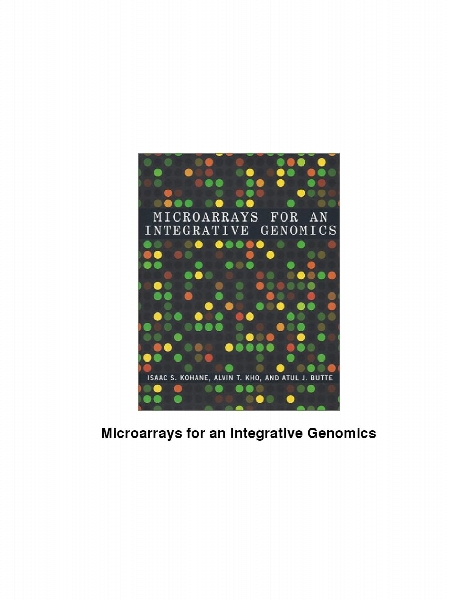Microarrays for an integrative genomics
- نوع فایل : کتاب
- زبان : انگلیسی
- مؤلف : Isaac S Kohane; Alvin T Kho; Atul J Butte
- ناشر : Cambridge, Mass. : MIT Press
- چاپ و سال / کشور: 2003
- شابک / ISBN : 9780262112710.
Description
Microarrays for an Integrative Genomics........................................................................................1 Foreword...........................................................................................................................................2 Preface...............................................................................................................................................3 Acknowledgments...................................................................................................................4 Chapter 1: Introduction....................................................................................................................7 1.1 The Future Is So Bright…..................................................................................................7 1.2 Functional Genomics.........................................................................................................9 1.2.1 Informatics and advances in enabling technology..................................................12 1.2.2 Why do we need new techniques?.........................................................................14 1.3 Missing the Forest for the Dendrograms, or One Aspect of Integrative Genomics..........15 1.3.1 Sociology of a functional genomics pipeline...........................................................18 1.4 Functional Genomics, Not Genetics................................................................................19 1.4.1 In silico analysis will never substitute for in vitro and in vivo...................................21 1.5.1 Biological caveats in mRNA measurements...........................................................23 1.5.2 Sequence−level genomics......................................................................................27 1.5.3 Proteomics..............................................................................................................29 1.5 Basic Biology...................................................................................................................29 Chapter 2: Experimental Design....................................................................................................32 2.1 The Safe Conception of a Functional Genomic Experiment............................................32 2.1.1 Experiment design space........................................................................................32 2.1.2 Expression space....................................................................................................34 2.1.3 Exercising the expression space.............................................................................38 2.1.4 Discarding data and low−hanging fruit....................................................................44 2.2 Gene−Clustering Dogma.................................................................................................48 2.2.1 Supervised versus unsupervised learning..............................................................49 2.2.2 Figure of merit: The elusive gold standard in functional genomics.........................51 Chapter 3: Microarray Measurements to Analyses......................................................................55 3.1 Generic Features of Microarray Technologies.................................................................55 3.1.1 Robotically spotted microarrays..............................................................................58 3.1.2 Oligonucleotide microarrays....................................................................................60 3.2 Replicate Experiments, Reproducibility, and Noise.........................................................70 3.2.1 What is a replicate experiment? A reproducible experimental outcome?...............71 3.2.2 Reproducibility across repeated microarray experiments: Absolute expression level and fold difference............................................................................................72 3.2.3 Cross−plat form (technology) reproducibility...........................................................75 3.2.4 Pooling sample probes and PCR for replicate experiments....................................76 3.2.5 What is noise?.........................................................................................................77 3.2.6 Sources and examples of noise in the generic microarray experiment...................78 3.2.7 Biological variation as noise: The Human Genome Project and irreproducibility of expression measurements....................................................................................86 3.2.8 Managing noise.......................................................................................................87 3.3 Prototypical Objectives and Questions in Microarray Analyses.......................................90 3.3.1 Two examples: Inter−array and intra−array............................................................91 3.4 Preprocessing: Filters and Normalization........................................................................93 3.4.1 Normalization..........................................................................................................94 i Table of Contents Chapter 3: Microarray Measurements to Analyses 3.5 Background on Fold.........................................................................................................98 3.5.1 Fold calculation and significance..........................................................................100 3.5.2 Fold change may not mean the same thing in different expression measurement technologies.....................................................................................102 3.6 Dissimilarity and Similarity Measures............................................................................104 3.6.1 Linear correlation..................................................................................................105 3.6.2 Entropy and mutual information............................................................................106 3.6.3 Dynamics..............................................................................................................111 Chapter 4: Genomic Data−Mining Techniques...........................................................................114 4.1 Introduction...................................................................................................................114 4.2 What Can Be Clustered in Functional Genomics?.........................................................114 4.3 What Does it Mean to Cluster?......................................................................................115 4.4 Hierarchy of Bioinformatics Algorithms Available in Functional Genomics....................115 4.5 Data Reduction and Filtering.........................................................................................118 4.5.1 Variation filter........................................................................................................119 4.5.2 Low entropy filter...................................................................................................119 4.5.3 Minimum expression level filter.............................................................................122 4.5.4 Target ambiguity filter............................................................................................122 4.6 Self−Organizing Maps...................................................................................................123 4.6.1 K−means clustering..............................................................................................127 4.7 Finding Genes That Split Sets.......................................................................................129 4.8 Phylogenetic−Type Trees..............................................................................................131 4.8.1 Two−dimensional dendrograms............................................................................135 4.9 Relevance Networks......................................................................................................137 4.10 Other Methods.............................................................................................................144 4.11 Which Technique Should I Use?..................................................................................145 4.12 Determining the Significance of Findings.....................................................................148 4.12.1 Permutation testing.............................................................................................148 4.12.2 Testing and training sets.....................................................................................149 4.12.3 Performance metrics...........................................................................................151 4.12.4 Receiver operating characteristic curves............................................................152 4.13 Genetic Networks.........................................................................................................154 4.13.1 What is a genetic network?.................................................................................154 4.13.2 Reverse−engineering and modeling a genetic network using limited data.........154 4.13.3 Bayesian networks for functional genomics........................................................157 Chapter 5: Bio−Ontologies, Data Models, Nomenclature..........................................................163 Overview.............................................................................................................................163 5.1 Ontologies.....................................................................................................................164 5.1.1 Bio−ontology projects............................................................................................165 5.1.2 Advanced knowledge representation systems for bio−ontology...........................168 5.2 Expressivity versus Computability.................................................................................169 5.3 Ontology versus Data Model versus Nomenclature.......................................................171 5.3.1 Exploiting the explicit and implicit ontologies of the biomedical literature.............172 5.4 Data Model Introduction.................................................................................................176 5.5 Nomenclature.................................................................................................................181 5.5.1 The unique gene identifier.....................................................................................184 5.6 Postanalysis Challenges................................................................................................187 ii Table of Contents Chapter 5: Bio−Ontologies, Data Models, Nomenclature 5.6.1 Linking to downstream biological validation..........................................................187 5.6.2 Problems in determining the results......................................................................187 Chapter 6: From Functional Genomics to Clinical Relevance—Getting the Phenotype Right..............................................................................................................................................189 6.1 Electronic Medical Records...........................................................................................189 6.2 Standardized Vocabularies for Clinical Phenotypes......................................................190 6.3 Privacy of Clinical Data..................................................................................................191 6.3.1 Anonymization.......................................................................................................192 6.3.2 Privacy rules..........................................................................................................193 6.4 Costs of Clinical Data Acquisition..................................................................................193 Chapter 7: The Near Future..........................................................................................................195 Overview.............................................................................................................................195 7.1 New Methods for Gene Expression Profiling.................................................................195 7.1.1 Electronic positioning of molecules: Nanogen......................................................197 7.1.2 Ink−jet spotting of arrays: Agilent..........................................................................198 7.1.3 Coded microbeads bound to oligonucleotides: Illumina........................................199 7.1.4 Serial Analysis of Gene Expression (SAGE).........................................................201 7.1.5 Parallel signature sequencing on microbead arrays: Lynx....................................203 7.1.6 Gel pad technology: Motorola...............................................................................203 7.2 Respecting the Older Generation..................................................................................203 7.2.1 The generation gap...............................................................................................204 7.2.2 Separating the wheat from the chaff.....................................................................205 7.2.3 A persistent problem.............................................................................................206 7.3 Selecting Software.........................................................................................................206 7.4 Investing in the Future of the Genomic Enterprise.........................................................209 Glossary..............................................................................................................................211 A....................................................................................................................................211 B..........................................................................................................................................211 C.........................................................................................................................................212 D.........................................................................................................................................212 E..........................................................................................................................................212 F..........................................................................................................................................213 G.........................................................................................................................................213 H.........................................................................................................................................213 I...........................................................................................................................................214 M.........................................................................................................................................214 N.........................................................................................................................................214 O.........................................................................................................................................214 P..........................................................................................................................................215 S..........................................................................................................................................216 T..........................................................................................................................................216 References....................................................................................................................................217 List of Figures...............................................................................................................................227


